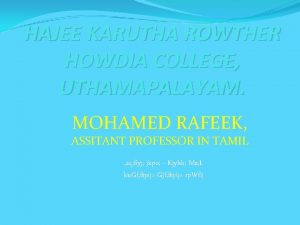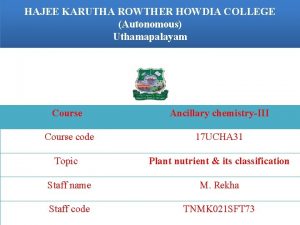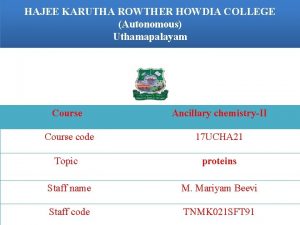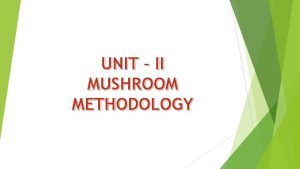HAJEE KARUTHA ROWTHER HOWDIA COLLEGE UTHAMAPALAYAM DEPARTMENT OF















- Slides: 15

HAJEE KARUTHA ROWTHER HOWDIA COLLEGE UTHAMAPALAYAM DEPARTMENT OF BIOCHEMISTRY NAME : V. VALAVANTHAL STAFF CODE: TNMK 021 SFT 145 COURSE NAME: PLANT BIOCHEMISTRY COURSE CODE: 17 UBCC 62 TOPIC: NITROGEN METABOLISM

NITROGEN METABOLISM •

SOURCES OF PLANTS TO PLANTS •

(3) Amino Acids (Organic Nitrogen) in the soil many soil micro-organisms make use of this from of nitrogen. Sometimes it may also be taken by higher plants. (4)Organic Nitrogenous Compounds in Bodies of the Insects Insectivorous plants fulfil their nitrogen requirement by catching the small insects and digesting them.

INTRODUCTION The plants in order to flower require a certain day length i. e. , the relative length of day night which night is called as photoperiod. The response of the photoperiod expressed in the from of flowing is called as photoperiodism. The phenomenon of photoperiodism was first discovered by Garner and Allard (1920, 22) who observed that the Biloxi verity of soya bean (glycine max) and Maryland mammoth variety of tobacco (Nicotiana tabacum) could be made to flower only when the daily exposure to the light was reduced below a certain critical duration and after many complex experiments conclude that ‘the relative length of day is a factor of the first importance in the growth and development of plant. Depending upon the duration of the photoperiod, they classified plant into three categories.

(1)SHORT DAY PLANTS (SDS) •


ØIn long day plant the light period is critical. ØA brief exposure in the dark period or the prolongation of the light period stimulates flowing in long day plants. (3)DAY NEUTRAL PLANTS These plants flower in all photoperiod ranging from 5 hours to 24 hours continuous exposure. Some of the example of these plants are tomato, cotton, sunflower, cucumber and certain varieties of peas and tobacco. during recent years certain intermediate categories of plants have also been recognised. There are, Long Short Day Plants: These are short day plants but must be exposed to long days during early period of growth for subsequent flowering. Some of the example of plants are certain species of Bryophyllum.

Short-Long Day Plants: These are long day plants but must be exposed to short days during early period of growth for subsequent flowering. some of the example of these plants are certain varieties of wheat (Triticum) and rye (Secale). PHOTOPERIODIC INDUCTION Plants may require one or more inductive cycles for flowering. An appropriate photoperiod in 24 hours cycle constitutes one inductive cycle. If a plant which has receive d sufficient inductive cycles is subsequently placed under unfavourable photoperiods, it will still flower. Flowering photoperiods (i. e. , discontinuous inductive cycles). This persistence of photoperiod after effect is called as photoperiodic induction.

v. An increase in the number of inductive cycles result in early flowering of the plant for instance Xanthium in the (a short day plant). requires only one inductive cycle and normally flowers after about 64 days. It can be made to flower even after 13 days if it has received 4 -8 inductive cycles. In such cases the number of flowers is also increased. v. Continuous inductive cycles promote early flowering than discontinuous inductive cycles. Some of the example of plants which require more than one inductive cycles for subsequent flowering are Biloxi soybean (SDP) -2 inductive cycles; salvia occidentalis (SDP)-17 inductive cycles; Plantago Lanceolata (LDP)-25 inductive cycles.

PERCEPTION OF THE PHOTOPERIOCIC STIMULUS AND PRESENCE OF A FLORAL HORMONE It is now well established that the photoperiodic stimulus is perceived by the leaves. As a result, a floral hormone is produced in the leaves which Is then translocated to the apical tip, subsequently causing the initiation of floral primordia. That the photoperiodic stimulus is perceived by the leaves can be shown by simple experiments on cocklebur (Xanthium pennsylvanicum), a short day plant. Cocklebur plant will flower if it has previously been kept under short-day conditions. If the plant is defoliated and then kept under short day condition, it will not flower. Flowering will also occur even if all the leaves of the except one leaf have been removed.

If a cocklebur plant whether intact of defoliated, is kept under long conditions it will not flower. But, If even one of its leaves is exposed to short day condition and the rest are under long day photoperiods, flowering will occur. The photoperiodic, stimulus can be transmitted from one branch of the plant to another branch. For example, if in a two branched cocklebur plant one branch is exposed to short day and other to long day photo period, flowering occurs on both the branches. Flowering also occurs if one branch is kept under long day conditions and other branch from which all the leaves except one have been removed is exposed to short day conditions. However , if one branch is exposed to long photoperiod and the other has been defoliated under short day condition. Flowering will not occur in any of the branches.

Nature of the Floral hormone Although there are firm evidences for the existence of a floral hormone but it has not yet been isolated. Therefore, the nature of this hormone which has been named as Florigen is not very clear. But it is quite evident that this hormone is a material substance which can be translocated from leaves to the apical tips situated at other parts of the plant resulting in flowering. Grafting experiments in cocklebur plants have even proved that the floral hormone can be translocated from one plant to another. For example, if one branched cocklebur plant. Which has been exposed to short day conditions, flowering occur on both the plants. Obviously the floral hormone has been transmitted to the receptor plant thought graft union. But if a cocklebur plant is grafted to another similar plant both of which have been kept under long day , flowering will not occur on either of the two plants.

It has also been indicated that the floral hormone may be identical in short-day and long-day plants for example, grafting experiments between certain long-day plant and short-day plants have shown that flowering occurs on both the plants even if one of them has been a under non-inductive photoperiods.

REFERANCE: v. Plant Biochemistry by Ross and Salisburry v. Plant Biochemistry by Bonner and Vamer, 3 rd edition, acadmic press.
 Hajee karutha rowther howdia college admission
Hajee karutha rowther howdia college admission Karutha thadi kathakali
Karutha thadi kathakali Pasadena city college police department
Pasadena city college police department Wake tech admissions
Wake tech admissions Early college high school at midland college
Early college high school at midland college Princeton physics department
Princeton physics department School education and literacy department
School education and literacy department Dental materials
Dental materials North palm beach police department
North palm beach police department Ohio department of taxation morse road
Ohio department of taxation morse road Sol score range
Sol score range National risk and resilience unit scotland
National risk and resilience unit scotland Cern te department
Cern te department Department of higher education and training
Department of higher education and training Growth management
Growth management Pleasant valley water department
Pleasant valley water department




























